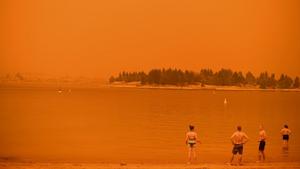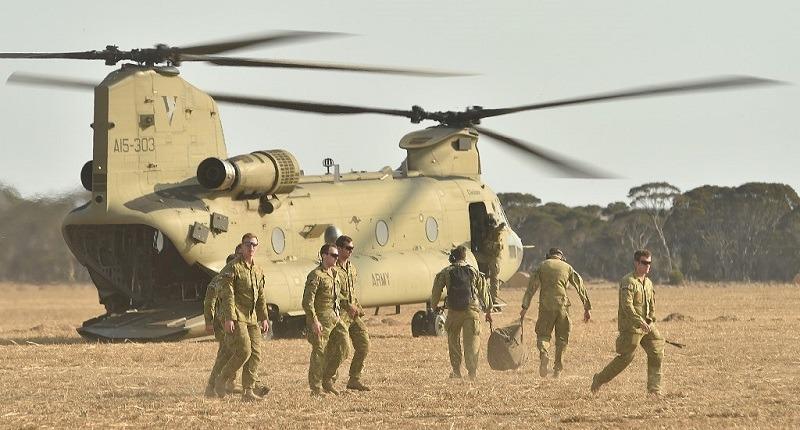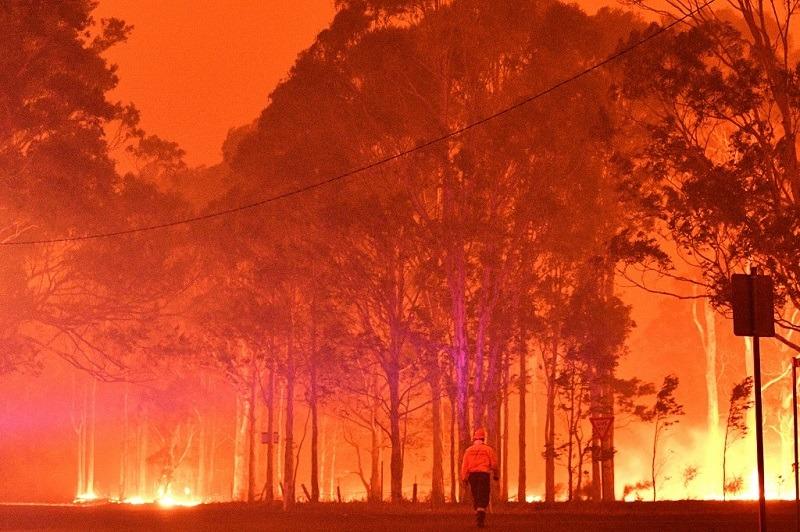 Residents take a dip to cool down at Lake Jindabyne, under a red sky due to smoke from bushfires, in the town of Jindabyne in New South Wales on Jan 4, 2020. (SAEED KHAN / AFP)
Residents take a dip to cool down at Lake Jindabyne, under a red sky due to smoke from bushfires, in the town of Jindabyne in New South Wales on Jan 4, 2020. (SAEED KHAN / AFP)
The fabric of Australian life, that sun-licked, healthy, outdoor way of living that has drawn people to the continent for decades, is under assault.
The unprecedented wildfires that have killed at least 28 people, incinerated an area almost the size of England and blanketed cities with toxic smoke, have also dealt a psychological blow to the nation. Behind the debris of the disaster lies the dread among many Australians that more of these extreme, weather-driven catastrophes could threaten the outdoor lifestyle for which the nation is famous.
This is going to change the whole way we organize our lives
Angela Rintoul, a health policy researcher from Melbourne
“This is going to change the whole way we organize our lives,” said Angela Rintoul, a 39-year-old health policy researcher from Melbourne, who was stranded in the beachside resort of Mallacoota on the southeast coast with her 17-month-old son Rex, partner and parents when fire swept into town in the final days of 2019.
ALSO READ: Aussie firefighters save extremely rare ‘dinosaur trees’
They sheltered in a cinema with about 650 others as flames raced through the main street. Rintoul and her family were eventually evacuated on an Australian Navy transport ship, the 16,000-ton HMAS Choules. She fears it may become too risky to spend summer vacations at the beach or in the wilderness.
Rintoul said the crisis, which has burned through more than 10 million hectares across all six Australian states, destroyed or damaged more than 3,000 homes and killed an estimated 1 billion native animals, is making her think about bigger things than just holiday plans: “Our future in general, what we are leaving our children, and the world we are creating for them.”
 This photo taken on Jan 16, 2020 shows an Australian Defence Force helicopter landing on Kangaroo Island as part of the deployment of 3,000 soldiers to assist in bushfire-affected areas after they ravaged the island off of the south coast of Australia. (PETER PARKS / AFP)
This photo taken on Jan 16, 2020 shows an Australian Defence Force helicopter landing on Kangaroo Island as part of the deployment of 3,000 soldiers to assist in bushfire-affected areas after they ravaged the island off of the south coast of Australia. (PETER PARKS / AFP)
Coordinating a nationwide response, Prime Minister Scott Morrison has sent in 3,000 army reservists to help the largely volunteer rural fire services and committed A$2 billion (US$1.4 billion) for the recovery. Still he’s refused to step up efforts to curb carbon emissions at the expense of jobs and growth, instead focusing on practical steps Australia can take to become more resilient to climate-driven threats, including building dams, clearing land and being more discriminating about where homes can be built.
But it’s beyond any government to control the climate. Australia’s crisis is a wake-up call for individuals to shake off the lethargy that has long blighted efforts to slow global warming, and take personal responsibility for the impact it’s having on their lives.
While heavy weekend rains bought some relief to firefighters, more than 60 blazes are still burning across New South Wales, according to the Rural Fire Service. Conditions are set to worsen again, with temperatures in parts of Sydney forecast to top 40 degrees Celsius (104 degrees Fahrenheit) on Thursday.
 A handout photo taken and received on Jan 17, 2020 from the Australian Reptile Park shows a staff member carrying koalas during a flash flood at the Australian Reptile Park in Somersby, some 50 kilometres north of Sydney. (HANDOUT / AUSTRALIAN REPTILE PARK / AFP)
A handout photo taken and received on Jan 17, 2020 from the Australian Reptile Park shows a staff member carrying koalas during a flash flood at the Australian Reptile Park in Somersby, some 50 kilometres north of Sydney. (HANDOUT / AUSTRALIAN REPTILE PARK / AFP)
Australian school kids, reared on a diet of outdoor play and sunscreen, have been shuttered inside this fire season to escape what at times has been the most dangerous air on the planet. Cherished beaches have been turned into refuges of last resort for thousands of holidaymakers escaping massive fires tearing through forested coastal communities. Dozens of national parks - home to remote walks and camping grounds, eucalyptus trees, wallabies and koalas - have closed, if they haven’t burned out.
READ MORE: Aussie PM proposes high-powered probe into bushfires response
It’s a trajectory with parallels in wildfire-ravaged California, perhaps Australia’s most obvious equivalent in the northern hemisphere. Both Australia and the Golden State have hot and dry summers, beaches, forests and vineyards, and both appear to be on a collision course with a changing global climate.
 A firefighter walks past burning trees during a battle against bushfires around the town of Nowra in the Australian state of New South Wales on Dec 31, 2019. (SAEED KHAN / AFP)
A firefighter walks past burning trees during a battle against bushfires around the town of Nowra in the Australian state of New South Wales on Dec 31, 2019. (SAEED KHAN / AFP)


